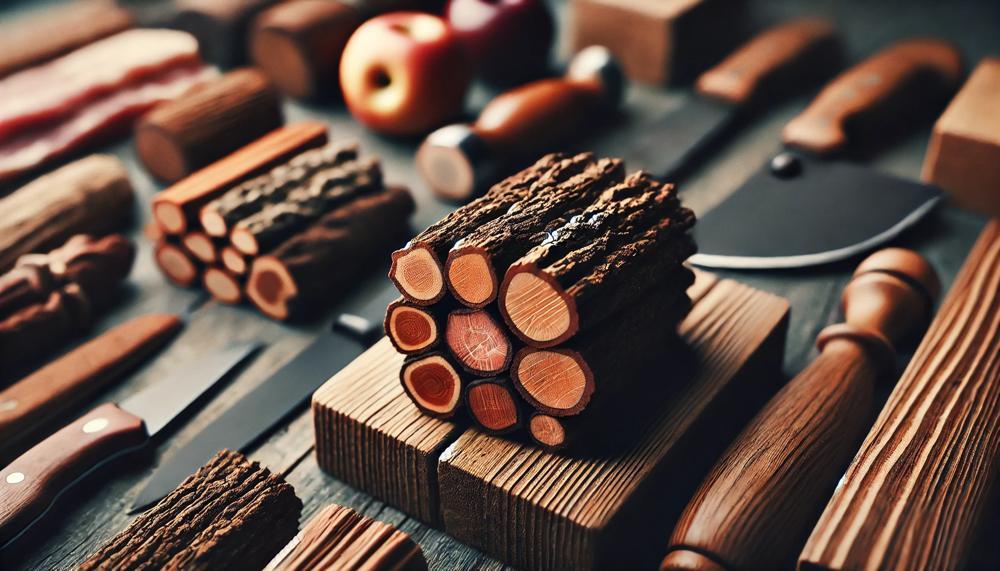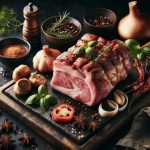Yes, choosing the right wood for smoking pork is essential to achieving the best flavor. Different wood types impart unique tastes, transforming ordinary pork into a mouthwatering delight. Here’s a quick guide to the best woods for smoking pork and their distinct characteristics:
- Apple: Perfect for a mild, sweet flavor that pairs well with pork loin.
- Hickory: Offers a strong, smoky taste ideal for pulled pork and pork butt.
- Oak: A versatile option with a classic smoky flavor, great for pork shoulder.
- Pecan: Adds a rich, nutty flavor that’s excellent for pork ribs.
- Maple: Provides a sweet, subtle taste perfect for ribs and ham.
Mixing these woods can create unique flavor profiles, enhancing your smoking experience. This article will guide you through selecting the best wood for your pork, ensuring your smoked dishes are packed with the perfect flavor.
Contents
Apple
Apple wood is a favored choice among pitmasters for smoking pork due to its mild and subtly sweet flavor profile that complements rather than overwhelms the natural taste of pork. This gentle sweetness pairs particularly well with the savory richness of pork, infusing the meat with a light, fruity essence that enhances its overall flavor without masking it. The popular types of apple wood used for this purpose include various regional varieties, each bringing a slightly different nuance to the smoked meat.
Here’s a breakdown of how apple wood influences the taste of smoked pork, highlighting its distinctive attributes:
| Wood Type | Flavor Profile | Best Used For |
| Standard Apple Wood | Mild with a hint of sweetness | Pulled pork, pork loins |
| Crab Apple Wood | Slightly sharper, tangier than standard apple wood | Pork ribs, pork chops |
| Wild Apple Wood | Richer and more robust, with a deeper sweetness | Thicker cuts like pork shoulder |

The use of apple wood for smoking creates a smoke that penetrates the pork gently, resulting in a flavor that’s both enhanced and distinct. This quality makes it a top pick for both novice smokers and seasoned barbecue enthusiasts alike.
When smoked slowly over apple wood, pork can develop a golden-brown crust, known as the bark, which is highly prized for its texture and flavor. This wood is also well-suited for blending with other smoking woods, like hickory or oak, to tailor the flavor intensity to personal taste or specific recipes.
Pecan
Pecan wood lends a distinctive, sweet, and mildly nutty flavour to smoked pork, making it an exceptional choice for enhancing the meat’s natural succulence.
The richness of pecan complements pork’s robust character, adding a subtle depth that is less overpowering than hickory but more pronounced than the gentle notes of apple wood used by many pitmasters.
| Wood Type | Flavour Profile | Recommended Use |
| Pecan | Sweet, slightly nutty | Ideal for pork |
| Apple | Mild sweetness, gentle fruitiness | Best for enhancing natural pork flavours |
| Hickory | Strong, hearty | Suitable for bolder smoked dishes |
This nuanced flavour profile of pecan is particularly suited to those who prefer a smoke that introduces a mellow sweetness to the meat, ideal for pulled pork where the sweet, nutty undertones can mingle with the pork’s fattiness to produce a truly delectable dish.
Maple
When maple wood is used for smoking pork, it imparts a uniquely mild and subtly sweet flavor that complements the natural sweetness of the pork. This makes it a top choice for cuts like ham, bacon, and ribs, enhancing their flavor without overwhelming the meat’s inherent qualities.
| Wood Type | Flavor Profile | Best Used For |
| Maple | Mild and subtly sweet | Pork (especially ham, bacon, ribs) |
| Pecan | Sweet and nutty | Pulled pork, for a mellow sweetness |
This gentle sweetness of maple smoke is particularly effective in enhancing the palatable experience of pork by layering a delicate touch of sweetness atop the pork’s natural flavours, thus enriching the overall taste without masking the meat’s original flavour profile.
Ideal for those who appreciate a hint of sweetness, maple wood smoking turns an ordinary pork dish into a remarkable feast for the senses, tenderly elevating its taste. This unique characteristic sets maple apart from stronger woods like hickory, making it a preferred option for those who seek a less intense smoking effect with a sweeter finish.
Orange
| Aspect | Details | Insight |
| Flavor Profile | Orange wood adds a citrusy undertone to smoked pork, infusing it with a subtle hint of tanginess that complements the meat’s natural richness. | Its distinct flavour is noted for providing a delicate balance, enhancing without overwhelming. |
| Smoke Intensity | The smoke from orange wood is moderate, allowing the pork to absorb flavours without becoming overly intense. | It contributes subtly to the overall taste profile, offering a nuanced smoking experience. |
| Application | Best used with lighter meats like pork or chicken, where its gentle flavour can be fully appreciated. | It is often chosen by chefs seeking to impart a unique twist to their smoked dishes. |
Orange wood plays a crucial role in smoking pork by imparting a citrusy tang that enriches the meat’s flavour profile. Unlike stronger woods, such as hickory or mesquite, orange wood offers a more delicate smoking experience. Its moderate smoke intensity allows the pork to absorb just the right amount of flavour, ensuring a balanced taste.
Chefs often favour orange wood for lighter meats like pork because it adds a subtle citrus undertone without overpowering the natural meat flavours. This makes it an excellent choice for those looking to elevate their smoked dishes with a touch of unique citrus essence.
Peach
| Flavor Profile | Characteristics | Impact on Pork |
| Sweetness | Peach wood offers a subtle sweetness, enhancing the pork’s natural flavours without dominating. | Complements the savory notes of pork, creating a balanced and nuanced taste experience. |
| Delicacy | Known for its gentle smoke, peach wood imparts a mild, smooth flavour. | Allows the pork’s delicate taste to shine through while infusing a light smokiness. |
| Aroma | Has a pleasant, fruity aroma that adds a hint of freshness to the meat. | Enhances the overall sensory experience, making the dish enticing from the first whiff. |
Peach wood, favoured in Southern BBQ traditions, enriches smoked pork with a delicate sweetness and gentle smokiness. It enhances the pork’s natural flavours without overwhelming them, making it ideal for those who appreciate a nuanced taste.
What to Avoid
When selecting wood for smoking pork, avoiding common mistakes is crucial to achieve that perfect smoky flavour. Here are key missteps to steer clear of:
Choosing the Wrong Wood Type
Not all woods are suitable for smoking pork. Avoid using resinous softwoods like pine and cedar, which can impart a bitter taste and harmful chemicals.
Ignoring Wood Preparation
Ensure the wood is well-seasoned and dry. Moist wood can lead to excessive smoke and an unpleasant acrid flavour.
Overloading the Smoker
Using too much wood can overwhelm the pork with too strong a smoke flavour, masking the natural taste of the meat.
Neglecting Manufacturer’s Recommendations
Always consider the smoker manufacturer’s guidance on the type and amount of wood ideal for your unit.
Skipping Trial and Error
Each type of wood imparts a different flavour. Experiment with various woods to find the best match for your taste preference and the specific cut of pork.
Alder
Alder wood imparts a distinctive flavour to smoked pork, characterised by its mild sweetness and subtle smokiness. This gentle infusion enhances the pork’s natural taste without overshadowing it, providing a harmonious balance that is both delicate and rich.
The unique flavour profile of alder wood can be broken down as follows:
| Characteristic | Description | Effect on Pork |
| Mild Sweetness | Alder wood emits a light, sweet smoke that complements the pork’s inherent flavours. | Enhances the meat’s natural sweetness, creating a more nuanced taste. |
| Subtle Smokiness | The smoke from alder is less intense compared to stronger woods like hickory or mesquite. | Imparts a gentle smoky flavour that doesn’t overpower the pork, maintaining its delicate texture. |
| Balanced Aroma | The aroma is pleasant and inviting, not overwhelming. | Adds a refined, savoury note to the pork, making it more appealing without being too strong. |
This balance is perfect for those who enjoy a more delicate smoky flavour rather than an overpowering one. Alder’s unique flavour works especially well with pork, making it a favourite among many grilling enthusiasts.
Its ability to enhance without overwhelming allows the natural characteristics of the pork to shine through, providing a more sophisticated and enjoyable eating experience.
Mesquite
Mesquite wood imparts a distinctive and robust flavor when used for smoking pork. The unique characteristics of mesquite smoke include:
| Flavor Profile | Description | Usage Tips |
| Earthy | Mesquite has a deep, earthy aroma that permeates the meat, offering a rich and natural taste reminiscent of the Southwestern deserts. | Best combined with milder woods like apple or cherry to avoid overwhelming the meat. |
| Spicy | The smoke from mesquite wood carries a subtle, spicy kick that adds a zesty undertone to the pork. | Use mesquite sparingly; too much can result in a bitter aftertaste. |
| Intense | Mesquite provides a strong, intense smoke flavor that is unmistakable and bold, ideal for those who prefer a pronounced smoky taste. | Ideal for shorter smoking sessions to control the potency of the smoke flavor. |
Mesquite is renowned for its powerful and unique flavor profile, making it a favourite among grilling aficionados who seek a bold and distinctive taste. The earthy and spicy notes combine to create an intense experience that stands out, even when the meat is seasoned or marinated.
To achieve a balanced flavor, it is often recommended to mix mesquite with lighter woods such as apple, cherry, or alder. This approach helps to temper the intensity while still benefiting from mesquite’s unique qualities.
Conclusion
Choosing the right wood for smoking pork is key to achieving a remarkable flavor. Each type of wood brings its own unique taste, turning ordinary pork into a mouthwatering delight. Here’s a quick rundown of the best woods for smoking pork:
- Apple: Delivers a mild, sweet flavor that enhances pork loin. Its gentle smokiness allows the meat’s natural taste to shine, perfect for beginners and seasoned pitmasters alike.
- Hickory: Known for its strong, smoky flavor, hickory is ideal for robust cuts like pulled pork and pork butt. It provides a hearty, bold taste that stands out.
- Oak: A versatile wood with a classic smoky flavor, making it a great choice for pork shoulder. It strikes a good balance between strength and subtlety.
- Pecan: Adds a rich, nutty flavor that pairs excellently with pork ribs. It’s less intense than hickory, providing a sweet, mellow smoke.
- Maple: Offers a sweet, subtle flavor, ideal for ham and ribs. Maple’s mild smokiness enhances the meat without overpowering it.
Mixing these woods can create unique flavor profiles, allowing you to tailor the taste to your preference. Avoid resinous woods like pine and cedar, which can impart a bitter taste and harmful chemicals.






